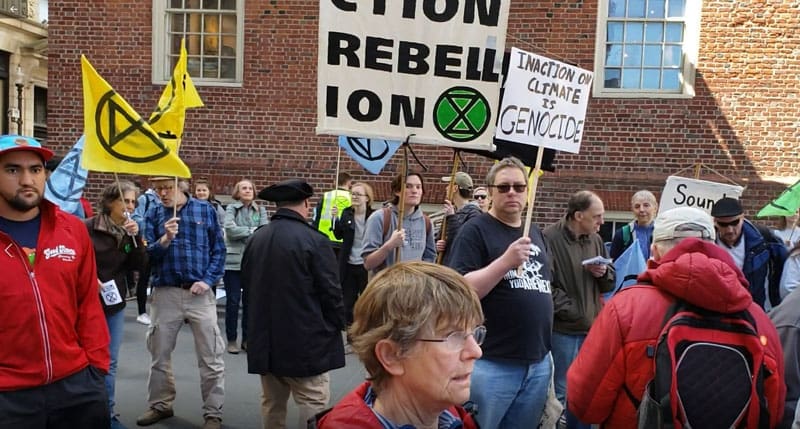“Everything is connected to everything else.” – Barry Commoner, The Closing Circle
Like most climate activists, for a long time I thought that greenhouse gas (GHG) emissions were THE driving force behind climate change. It followed that reducing emissions was our overriding goal.
A steady stream of messages from both the climate movement and the mainstream media are constantly reinforcing the perception that GHGs and the climate emergency are synonymous. The most prominent activist organization is named after atmospheric carbon levels. Even the climate deniers reinforce this focus when they react against the claims of scientists and activists about carbon. GHGs and what to do (or not do) about them frame the debate.
Biodiversity for a Livable Climate is dedicated to expanding the terms of the climate conversation. We want to bring to the table measures for restoring degraded and desertified lands, re-establishing balanced water cycles, managing forests and reforestation, and restoring ocean food chains. This is not instead of working to reduce GHG emissions, but in addition. These are measures that have the potential to store huge amounts of carbon in the soil, reduce flooding and drought by stabilizing local climates, address the immediate dangers posed by the world’s diminished water supplies, restore habitable environments for innumerable species, increase food supplies and create jobs. Why would such measures not be on the climate table in addition to emission reduction?
Spanning the specific benefits of individual measures is the overarching need to restore the balance of Earth’s interconnected natural systems. Why would we not place carbon reduction into this larger ecological context?
* * *

I can think of several reasons why it’s not easy to change the conversation.
It takes a lot of emotional work to face the seriousness of the climate emergency. A big part of that work involves trying to gain some degree of intellectual mastery of the situation. Once you feel like you understand what’s going on, it’s natural to become invested in that explanation.
We climate activists who are not ourselves scientists (the vast majority of us) face the challenge of sorting out scientific explanations, drawing our own conclusions and figuring out whom in the public arena we trust. When prominent climate scientists and activists make statements that focus exclusively on carbon build-up and the urgent need for reductions, most of us are willing and eager to believe them. Then along comes ecologist Allan Savory promoting a holistic land management system which can restore degraded grasslands so quickly and effectively that, if done on a large enough scale, atmospheric carbon can be reduced by storing it in healthy soil (https://savory.global/). And along comes a team of Slovakian water scientists saying that the depletion of ground water and its impact on regional water cycles may have more effect on climate instability than GHGs (http://www.vodnaparadigma.sk/indexen.php?web=./home/homeen.html). And along comes Biodiversity for a Livable Climate saying we need to change the climate conversation. Who are these people? Why should we trust them with their different, more complex messages? How can we make sense of apparently conflicting claims?
If we really try to take seriously the ecological framework – which changing the conversation invites us to do – the challenges multiply. We may celebrate Barry Commoner’s wisdom that everything is connected to everything else, but how do you actually parse out the innumerable devils in the avalanche of environmental details? Problems with one cause and one solution seem manageable, or at least capable of being understood, even if the solution fails to materialize. Trying to take in the true complexity of the Earth’s interconnected systems can be intellectually and emotionally overwhelming.
Underlying all particulars of the climate emergency is a crisis of imagination. Humans are hard-wired to respond in concrete ways to our immediate environments and to the tangible data that we can see and touch, that we experience having a direct bearing on our lives. It is already a leap to make connections between an abstract number representing carbon accumulation up in the atmosphere, the melting of ice in distant places, and dire threats to our collective and personal futures. Now we are being asked to make more leaps to more distant places and possibilities, to African grasslands and water evaporation cycles and ocean phenomena, to connect all these dots and see how they lead to greater possibilities for a sustainable future.
* * *
If greenhouse gas emissions were rapidly declining; if the arctic were not already melting; if our forests weren’t burning; if extreme weather events were not multiplying; if methane were not already seeping out of thawing permafrost – under these imagined conditions, we might get away with a single-minded focus on carbon (or we might not). But the hard reality is that carbon emissions continue to rise, and climate change is careening out of control.
This is a moment when we need somehow to find and act from our best selves. Which means stretching as far as we possibly can to face the hard realities and to consider options that have the potential to address them. It also means facing our own limitations and the almost unbearable emotional challenges of the climate emergency, and finding creative ways to cope and to support one another.
Changing the climate conversation does not ask us to accept new claims only on faith. It asks us to engage in the difficult and necessary work of investigating possibilities for climate stability in addition to and beyond human-caused carbon emissions. It means doing our best thinking and drawing on our best resources, opening our minds and our hearts to new ways of responding to the brave new world that bears down upon us.

